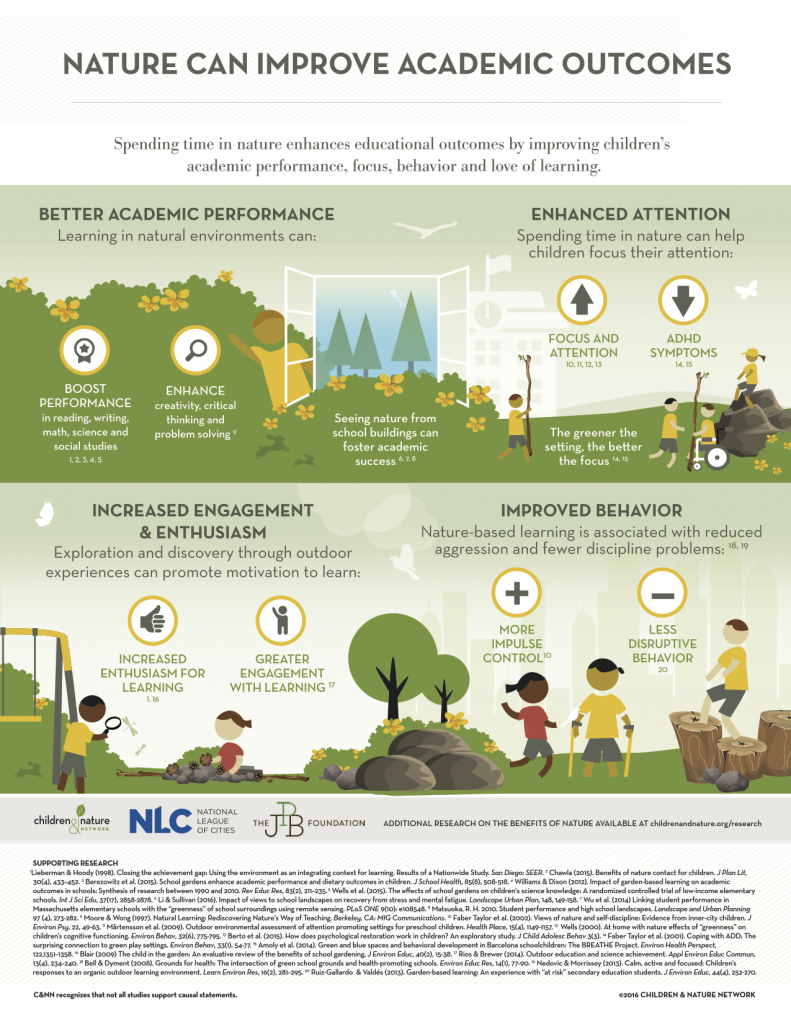
Because we’re becoming more and more aware of how nature benefits peoples’ overall health in wonderful ways, it just makes sense that nature can play a part in helping our kids succeed in school.
Before we get to the infographic, allow me to introduce its publisher, for those who haven’t heard of them…
Children & Nature Network, a Local Non-Profit
Children & Nature Network is a 501c3 non-profit based right here in Minneapolis. Here’s their purpose as an organization (from their About page):
“Nature has the power to make children healthier, happier and smarter. But over the last few generations, childhood has moved indoors, leaving kids disconnected from the natural world. This worldwide trend has profound implications for children’s healthy development—and the future of our planet.”
Because of that, their Vision is:
“A world in which all children play, learn and grow with nature in their everyday lives.”
Why Have Kids Moved Indoors?
So, first of all, why have kids moved indoors in the last generation or two (maybe just one…I played outside every day as a kid—I’m 53)
I’ll summarize reasons given on C&NN’s site:
- The wide-spread use of electronics, even by young and very young children
- Poor urban planning
- Disappearing open spaces
- Increased street traffic
- Schools not emphasizing the natural world in their curriculum
- Parental fear magnified by the media (both news and entertainment)
Another reason, based on my own observation, is many kids are SO BUSY with a constant stream of organized activities there’s no time to play outside. The neighborhood pick-up game (in any given sport) used to be commonplace. We don’t see that nearly as much anymore.
What Are the Implications of Kids Moving Indoors?
C&NN’s co-founder, Richard Louv, coined the term Nature-Deficit Disorder. It’s not a medical term, but sure makes us perk up and wonder how serious this is.
Quite a lot of research worldwide suggests that children who live almost exclusively indoors are at a decided disadvantage compared to those who get their daily dose of nature:
- Diminished use of their senses
- Difficulty focusing, paying attention
- Obesity
- Higher rates of both emotional and physical illness
Can you see how these things will negatively affect kids at school? Inability to stay focused…higher rates of illness…
Of course we can’t blame these negatives just on nature deficit. But what would happen if we were able to reverse this trend and make it normal again for kids to play outside daily?
OK, here’s where the infographic comes in:
“Nature Can Improve Academic Outcomes”

As you can see, they’re attributing a lot of success indicators to spending time in nature:
- Better academic performance. Even being able to look out the window at a natural setting is good for them (and adults, too!)
- Enhanced attention.
- Increased engagement and enthusiasm
- Improved behavior. This is probably largely because the kids get a chance to run around outside! Run off the fidgets and they’re more likely to be able to sit still for awhile in class.
How Can We Help Change Towards Nature and Away from Indoors?
While schools have a role, too, undoubtedly, it’s really parents who have the biggest impact on our own kids’ lifestyles.
The best way to get your kids out in nature is to take them yourself. Build your family life in such a way that green space, nature, the outdoors are part of your everyday experience.
Bring your kids to amazing natural places. As a family, find one or two or six outdoor, nature-based things you can do together. Frequent the nearest parks, lakes and rivers.
We have an absolutely wonderful collection of parks in our metro area, including right in the centers of Minneapolis and St. Paul. Use them!
And don’t make the mistake of thinking you can only do it during our short summer. Take advantage of the uniqueness of every season—even winter.
Whether your child is a preschooler yet, or is in a public, private or home school—finding a way to include daily nature-time is a worthy goal to aim for.
Take a look at our Twin Cities Guides collection for ideas on where to go as a family!
NOTE: The above infographic is a free download from Children & Nature Network. You’ll find it, along with other freebies, on their Tools & Resources page.
You’ll like these, too…
- Why Nature is So Good for Us
- Why Outdoor Play is So Good for Our Kids
- Outdoor Recreation Education in the Twin Cities
- New Winter Gear: How Do These Perform? - November 29, 2023
- Paddle North: SUPs, Kayaks and More - November 20, 2023
- 2023 Holiday Gift Guide for Outdoor Lovers - November 10, 2023
